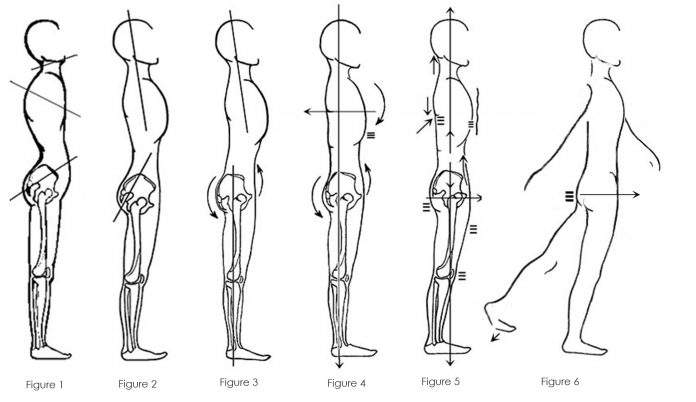If you’re one of the millions of individuals who suffer from low back pain — and if that doesn’t apply to you now there’s a high probability that one day it will — this article is for you.
The simple truth is, whether in men or in women, swayback, in my opinion, is the number one reason for low back pain.
When I wrote about the connection between swayback and back pain thirty-five years ago, it pretty much fell on deaf ears. Now, even guys who run gyms and who normally pitch bench presses and weight lifting are making videos about the dangers of “forward pelvic tilt,” another way of saying lower back arching, or swayback, and recommending the pelvic tilt as a remedy.
Another common suggestion over the years has been to flatten your back against a wall, with your knees slightly bent, and to keep your back flat as you walk away. Of course, you can only do that if you keep your knees bent and, to my mind, that’s not a satisfactory option.
Corrective exercise
More recently, I’m glad to see “corrective exercise” as the way to solve the problem of back pain. It’s a term I steered clear of back in the days when because it sounded so institutional and unappealing in comparison to the energy of aerobics, but it’s a good thing that it’s come into use because it’s exactly what the doctor should have ordered.
.
Often overlooked, though, is that while an exercise can be correct in itself, it has to be done in the context of the body as a whole. The fact is, changing one part of the body doesn’t really work. The connecting parts need to be changed as well in a sequential process until all of the parts are together in a unified body that is properly aligned and supported.
Somatic Stretch ® exercises are just this kind of sequential process. The exercises work with the separate parts of the body in a harmonious way so that the changes are gradually assimilated and the body comes to sense, and is comfortable with, a new way of being.
Today’s article is a follow-up to my March 16 blog, “My Rant About Swaybacked Posture,” where I mentioned that photos and diagrams that are generally shown as good posture have, according to my viewpoint, too much lower back arch.
A “straight” pelvis
Seemingly little considered, or at least written about, there is a position between the pelvic tilt and an over-arched lower back that I call “straight,” but which retains a natural curve in the lower back. The upper body, when aligned in its separate parts, is then carried along above the pelvis, much the way a paddle boat glides over the water.
That brings to mind a short piece called “When walking becomes gliding,” written by a recently graduated Instructor of Somatic Stretch®, which beautifully expresses the integration and the quality of movement that this work is meant to provide.
Today’s article shows the progression of adjustments the body goes through, each change resulting from the change before, to transform the most common form of bad posture into aligned, supported posture that has the potential for carrying the body forward in that gliding manner.
The ultimate goal of good posture
I can’t emphasize enough that, while the subject of improving posture is still not a cliffhanger for most people, it should be, because it’s the means of having a body that not only looks better, but works and feels at its optimum best, remains youthfully active, sustains few injuries and enjoys a state of good health and wellbeing throughout life. That’s the ultimate goal here and of Somatic Stretch® exercises, which help to bring that desirable condition about.
That said, I have to emphasize even more importantly that in the adult body a change of this proportion can take many years to accomplish, if ever, and it can have apparent adverse consequences. The body does not give up its familiar way of being easily and can quickly put up resistance.
Like the fable where the sun wins out over the wind in taking off the cloak of the traveler, the body has to be coaxed, rather than hurried or forced, into changing. The good news is that once it gets to “the other side,” it says, “Wow, thank you, I feel so much better this way!” So, despite the difficulties it may present, getting your posture right is worth aiming for.
For most people, bodily changes don’t happen by copying illustrations or even from following written descriptions. It’s in using the exercises that prepare the way for the changes to take place that the process of postural adjustments becomes clear.
This article is intended for informational purposes only. If you have any questions or are considering any new physical activity or recommendations, please consult your health practitioner.























